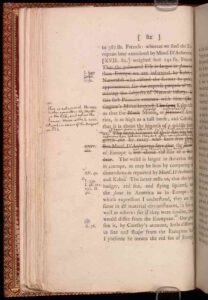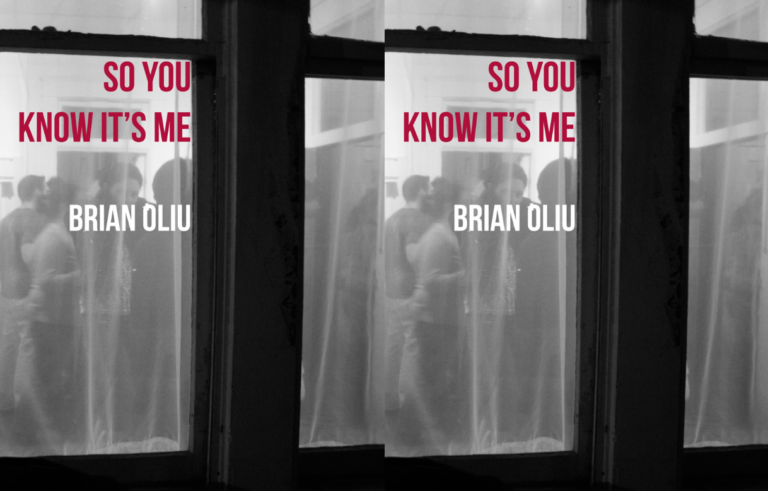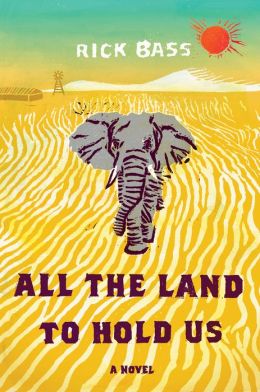People of the Book: Brad Pasanek
People of the Book is an interview series gathering those engaged with books, broadly defined. As participants answer the same set of questions, their varied responses chart an informal ethnography of the book, highlighting its rich history as a mutable medium and anticipating its potential future. This week brings the conversation to Brad Pasanek, assistant professor at the University of Virginia, whose work questions the “mind as metaphor” through hands-on literature, app-books, and digital humanities.
1. How do you define a “book”?
Almost immediately, I want to turn that question back: what isn’t a book? Or refer it to the eighteenth century, where I find the term coyly defined in Nathan Bailey’s Dictionarium Britannicum as “a thing well known” and extensively, in Samuel Johnson’s Dictionary, as “a volume in which we read or write.” The other book-people interviewed here (librarians, bibliographers, etc.) will be nicer of definition, I’m sure. But in an English department the book stands as a metonym of literature and learning. And it stands metaphorically for more besides. I call to mind commonplaces from antiquity and the Middle Ages: the book of the life, the Law written in the “tables of the heart.” Galileo and Bacon encouraged the Moderns to collate bibles and the codex naturae. The face is as legible as any page; infancy is a blank slate. And so on.
2. How do you engage regularly with books, beyond reading?
I teach books and write about them; I hunt for new ones in the library and recall interesting ones from colleagues and stack them on my desk. I take trips to D.C. or L.A. or London to visit the rare ones.
I am completing revisions of my own first book just now (to be published this year by Johns Hopkins University Press). It’s part monograph and part database, a scholarly experiment that digests thousands of metaphors of mind from eighteenth-century English literature. The metaphors are fixed in argument by the book, while the database, titled The Mind is a Metaphor, makes my evidence available for readers to search through and sort. In epigram: the book is the text; the database, a new kind of paratext.
I’m indexing the eighteenth century. I describe the work as a “dictionary” in order to invoke the wordbooks of Voltaire, Pierre Bayle, and Samuel Johnson. Voltaire’s was a philosophical dictionary; Bayle’s was a critical and biographical one; Johnson’s is closest to a modern dictionary. All three dictionaries are surprisingly writerly if not cantankerous, and more than mere compilations. Abecedarian order is a powerful formal device. And a headword becomes a reason to improvise an essay. I’ve written eleven of them: from “Animals” to “Writing,” my book alphabetically enstranges (that is, defamiliarizes) the grand narrative of the Enlightenment.
3. What has been your most unusual interaction with books?
When I taught high school, I once asked an underprepared class to color-code the title terms of Pride and Prejudice (and their synonyms) in the text of the paperback novel. When we met the next day, we discovered that riffling the pages produced explosions of red and blue at those plot points involving Elizabeth and Darcy. The distinction between story and discourse—like many formal abstractions—was made visible by closely and mechanically marking a text.
My interest in words is an abiding one. Because I study metaphors, I open a browser window on an electronic text collection and run proximity searches, looking for one keyword (a tenor) within one hundred characters of another (the vehicle). In graduate school I spent hours, days, weeks, months reading search results in KWIC concordances.
Here’s a snapshot of a proximity search for mind and mine, typical of the reading I do on my laptop. In the list, Samuel Bowden’s is first of several mineral metaphors of mind to appear:
This is a low-tech version of text mining in which I take on the heavy work that might eventually be carried out by machine learning algorithms. But for now, I continue to do a lot of desultory reading in online archives like Eighteenth Century Collections Online, Early English Books Online, and Google Books. I search by keyword, studying all the paragraphs in a book in which the word mind or soul appears. Every week I devote at least one workday to collecting and counting metaphors. I’ve collected 13,294 metaphors as of this morning. The effort is drudging by design. In a race against the machines, I play John Henry.
Marking metaphors, I sometimes think (aspirationally) of the obliterating beauty of Yayoi Kusama’s repetitive-compulsive artworks, built up from loops and dots. I think also of the eighteenth-century satirists who complain about “index-learning” and “bookful blockheads.”
4. Do you have favorite tidbits from the history of books?
I intend to write an essay about watermarks in the late eighteenth century: more specifically, about John Dunlap’s publication of the Declaration of Independence, which was printed on July 4, 1776, in Philadelphia, on paper watermarked with a crown. I would want to specify how the Declaration overstrikes that crown—and how the crown haunts the Declaration.
Crowns are standard in watermarks, but some early American papermakers incorporated different imagery. See, for example, the liberty bell (at left), which I discovered in the Special Collections of Honnold/Mudd Library.
I am fascinated, too, by the watermarks in early printings of Lyrical Ballads. Wordsworth’s “Tintern Abbey” is date-stamped to July 13, 1798 in its subtitle. The poem begins famously with the clause “Five years have passed” but is printed (I don’t know that this has ever been noted by literary critics) on paper watermarked “1795.” The paper-medium intervenes between Wordsworth’s visits to the Wye Valley in 1793 and 1798, it supports the verses occasioned by the second visit, and it belies—I think—the Romantic, transcendental sentiments forwarded in the poem.
5. What material part of the book interests you most?
At Stanford, I was taught by Jay Fliegelman, a brilliant character and great teacher, now, sadly, deceased—he was also a “People of the Book,” plural noun and all. It was Jay who taught me to read more than printed pages. He’d put a Paul Revere silver creamer in your hands and ask for an interpretation of the embossing. He showed his students how to read the shape of a Wedgwood serving dish or the structure of a Windsor chair. Jay proved to me that a material object could be as legible as a line of text. I’ve suffered happily enough from referential mania ever since.
Because of Jay, I’m interested in the way materiality figures meaningfully with and against printed text—watermarks, fold-out plates, marginal notations, and other book technologies augment and complicate our reading of an author.
The line between accident and meaning is especially provoking. Take as an example the Spectator papers, which were sold singly as folio half-sheets for a penny until a new tax on paper forced the publishers to double their prices in 1712. While those readers who could not afford to buy the periodical essays as they were printed could still buy them collected “in the Lump” at the end of run, the “Rich and Wealthy” were able to savor papers still fresh—so we are told by Mr. Spectator—in the “several Accidental Circumstances of Time, Place, and Person.” Such a reader might then collect and trim the loose sheets, binding together individual issues as in the copy pictured. Every physical book is thus shaped by accident and circumstance.
(Another accident: the placement of the tax stamp in the copy pictured above falls fortuitously close to Mr. Spectator’s description of papers sold singly like “Cherries upon the Stick”—and in the juxtaposition I can’t help but see the red stamp as a cherry.)
6. If your house was burning and you had to take three books, which would you save? Why?
I’d like to think I would save whatever library books are stacked on my nightstand (two or three just now): to be returned. But probably, pedagogically panicked, I would grab whatever books I had to teach the next day. On the sidewalk, while I watched the house burn, I’d remember my paperback copies of James Joyce’s Ulysses and Vladimir Nabokov’s Pale Fire, the margins of which are crammed with my undergraduate annotations. All those callow insights, up in smoke.
7. What about the current moment for books interests you?
We live in a period of remediation (I’m hearing, mutatis mutandis, Karl Polanyi’s title repurposed: The Great Remediation). The literature of the past is suddenly and newly available to the present—in the lump, as it were. It reminds me of the early eighteenth century: of the flood of translations, imitations, and piracies; the compilations and anthologies, and the publication of poems “by several hands” that had circulated previously only in manuscript.

I’m exercised by conflations of page and screen and delight in the absurdity of the rare-booker who, in a Grolier Club talk, laments the horrors of mass digitization and then displays a page image from an incunable in his Powerpoint slide show. As I skip, skim, and search in text collections, I routinely encounter bizarre scanning artifacts and am similarly brought up short. Musing on the “several hands” of early modernity and the root meaning of “digital,” I began to collect images of “Google hands”—that is, those traces of labor accidentally memorialized in Google Books. These evidences of manipulation usually feature an anonymous worker’s fingers caught on camera. I archived several locally; and then, a little over a year ago, I started a Tumblr on Hands On Literature, with links back to the books. I try to post a new image every few weeks.
8. Where do you go to find and/or give away books?
A local used bookstore (Heartwood Books) seems to have bought a great number of volumes from a now-retired, eminent eighteenth-centuryist who used to teach in my department. I buy her cast-off books as I find them. The prize is a copy of a monograph by another important UVA eighteenth-centuryist, filled with inscriptions. My colleague David Vander Meulen has also been helping keep books with provenance in the department and has passed on to me some minor treasures. Right now, thanks to David, I’m the caretaker of Irvin Ehrenpreis’s Bond edition of the Spectator papers, which previously had been in the care of Martin Battestin. Both Ehrenpreis and Battestin—important eighteenth-centuryists—left marginal notes in the volumes.
9. How do you foresee books evolving in the future?
Faculty in the English department have been talking about a digital anthology, a for-us-by-us effort, that would bring full-color page images of hard-to-edit texts to the tablet environment. As a proof of concept, John O’Brien and I created a tablet version of Thomas Jefferson’s Notes on the State of Virginia with funding from The Jefferson Trust. Jefferson’s text, which exists in multiple states and editions, is complicated, existing in manuscript and print copies that differ significantly.
Our goal was to build a difference engine that would enable students to compare two important copies of Notes owned by UVA (a 1785 private printing that Jefferson gave to the Marquis de Lafayette, shown left, and Jefferson’s own copy of the 1787 first edition, published in London, shown below right). We loosely collated the two editions, designed a scroller that keeps correlate pages in contact, transcribed Jefferson’s inscription to Lafayette as well as the corrections, additions, and marginalia in his personal copy, edited a modern reading text with annotations, and bundled it together with the page images.
We aimed originally at the iPad and intended to distribute our digital variorum for free, but a funny thing happened on the way to the App Store. We were rejected—three times. (Our story, a cautionary tale, is detailed at The Chronicle’s Profhacker blog as “This is Not a Book.”) We fell afoul of Apple’s corporate strategy, it seems, which divides tablet content into apps and books.
App/book: it’s a terribly invidious distinction. An e-book that isn’t obviously game-like or “interactive” is dismissed as being “simply a book.” A philistine phrase if ever I read one! But the App Review Team, at least, has a straightforward answer to the first question posed in this interview: a book is something submitted to the iBookstore, where it serves, more or less, as a container for text and video files.
For now, we have given up on the App Store and are redesigning Notes as an open web-based project that will work on a variety of devices. The Scholar’s Lab at UVA is leading the new programming effort, and I’m pleased to share a screen capture of the reading text. The online Notes will pull page images directly from the institutional repository and allow the reader to switch between text and image, as well as compare the editions.
10. What question do you wish that I had asked related in some way to books? Ask, then answer it.
- Q. Your wife informs me that you have been surreptitiously culling titles from your three-year old son’s library; mostly books that you can’t bear to read to him anymore. Which titles have disappeared? And what has happened to them?
- A. Well intentioned family and friends have given us some truly dreadful books. Some of these books I have hidden in places where it is unlikely they will soon be recovered. One benumbing tale—Mike and the Scary Noise—fell into the recycling bin and is now lost, for good. I find holiday books hard to take at any time of the year, but especially so out of season. Happy Easter, Curious George and its stickers might soon be banished to the basement.
______
Brad Pasanek teaches at the University of Virginia, where he is an Assistant Professor in the English department. His business card, if he had one, would tell you he is a distant-reading big-data digital humanist. And that he is fascinated by poetic diction, intellectual history, and commonplacing. His first book, Metaphors of Mind: An Eighteenth-Century Dictionary, is forthcoming from Johns Hopkins University Press.




